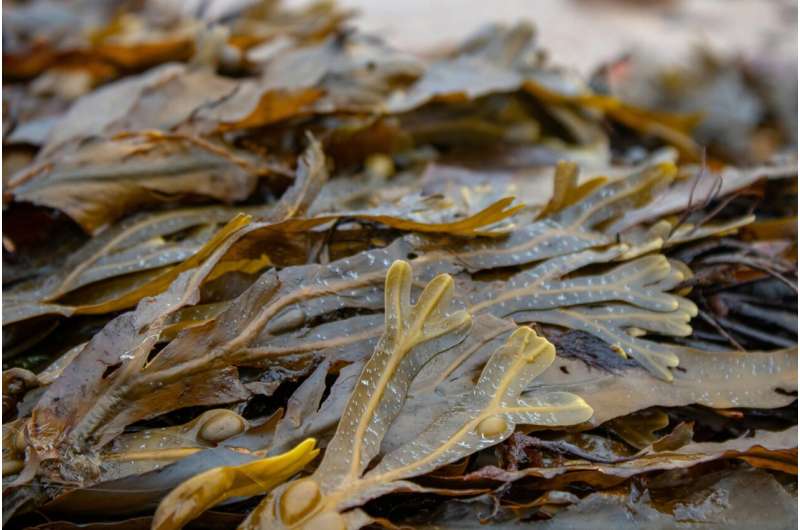This article has been reviewed according to Science X's editorial process and policies. Editors have highlighted the following attributes while ensuring the content's credibility:
fact-checked
trusted source
written by researcher(s)
proofread
The health benefits of seaweed—a bath full of bladderwrack might be just what the doctor ordered

Seaweed, the colorful macroalgae that grows in the ocean, is a food source for marine life and humans. Each type of seaweed has a unique set of nutrients and can boost vitamin and mineral intake if eaten regularly.
Seaweed is widely consumed in Asia, and a staple ingredient in many Japanese, Korean and Chinese dishes. For example, nori is well known as the seaweed used to wrap sushi rolls, while wakame or kelp are often found in comforting ramen noodle dishes. These seaweeds impart an instantly recognizable savory taste—known as umami flavor—to food and can add a variety of vitamins and minerals to meals.
Seaweed types can be broadly classified according to their color: red, green and brown. About 145 species of seaweed are eaten around the world. Seaweed is valued for its antioxidant properties, which help protect cells against free radical damage.
Many seaweeds contain phenolic and flavonoid compounds, which are important antioxidants, as well as omega-3 fatty acids, amino acids, fiber, vitamins A, C and E—and minerals such as copper, zinc and iodine.
The seaweeds with the greatest nutritional value include those often referred to as the "wracks." Bladder, toothed and spiral wracks often have notably higher antioxidant contents than many other seaweeds. However, nutritional content varies depending on the type of seaweed, harvest location and the season in which it's harvested.
As well as being nutritious, seaweed has potential as a source of valuable antimicrobial agents. Research from Queen's University Belfast has shown that seaweed species can fight off the growth of harmful microorganisms in animals, some of which are becoming resistant to antibiotics.
While eating seaweed has an array of benefits, there are a few things to watch out for. Due to the high iodine content in many seaweed species, seaweed consumption could exacerbate thyroid conditions or interfere with thyroid medications.
Some reports also suggest that, depending on the habitat, seaweed species may accumulate heavy metals such as cadmium, which has been reported to cause liver and kidney toxicity, and mercury, a known neurotoxin.
It's important, then, to check different countries' maximum contaminant levels (MCLs) for heavy metal concentrations in seaweed products and only purchase those which have been tested and deemed safe for consumption.
Seaweed bathing
But diet is not the only way to experience the benefits of seaweed.
In recent years, there has been an upsurge in seaweed bathing, which is believed to be beneficial to health. A bath full of bladderwrack might not seem very appealing—but this strap-like, olive colored seaweed, found along the coasts of the North Sea, Atlantic Ocean and Pacific Ocean, has been shown to have beneficial effects as a topical treatment for various skin issues from skin aging to wound healing.
The tradition of seaweed bathing, which has been practiced for hundreds of years, was originally recommended for arthritis sufferers to ease pain, stiffness and inflammation of joints. Nowadays, it is also recommended for athletes after a strenuous workout because seaweed's high magnesium content is believed to be soothing for aching muscles.
Many companies that specialize in the harvesting of seaweed for bathing purposes aim to do so sustainably. This means that the seaweed is cut from the reef at low tide and is never pulled from the root to ensure regrowth. As demand increases, there is a growing awareness of the challenges around growing and harvesting methods, technical know how and environmental impact of expanding production.
The moisturizing effects of seaweed are also prized by the beauty industry as today's consumers place greater value on natural—and environmentally friendly—skincare ingredients.
Containing extracts of seaweeds such as toothed wrack and sea spaghetti, seaweed-based skincare lines claim anti-photoaging, hydrating and protective, nourishing and skin-plumping effects. But check the label: the closer to the top of the ingredient list, the greater the amount of seaweed in the product.
So, to enhance your health, seaweed can be easily incorporated into your lifestyle. Add to your diet, in moderation, by exploring seaweed recipes and by sprinkling dried, ground seaweed mixtures featuring dulse, wakame, sea spaghetti and wracks into smoothies, over salads and even on pizza.
It is also possible to buy hand harvested seaweed products for adding to the bath so that the benefits of submerging in marine algae can be realized from home—no matter how far from the sea we may live.
This article is republished from The Conversation under a Creative Commons license. Read the original article.![]()





















